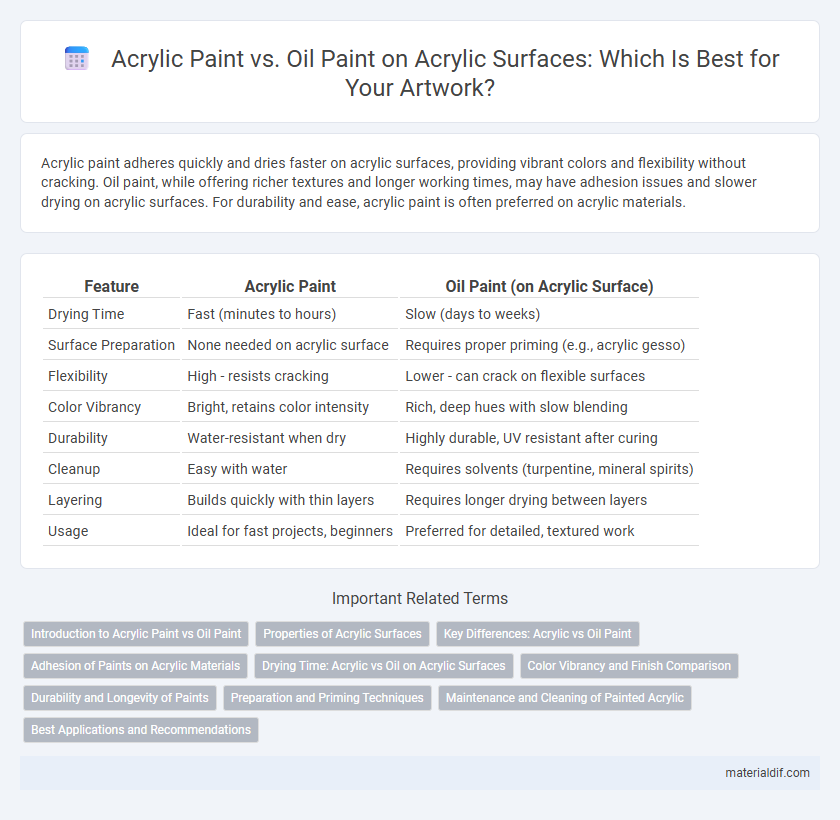Acrylic paint adheres quickly and dries faster on acrylic surfaces, providing vibrant colors and flexibility without cracking. Oil paint, while offering richer textures and longer working times, may have adhesion issues and slower drying on acrylic surfaces. For durability and ease, acrylic paint is often preferred on acrylic materials.
Table of Comparison
| Feature | Acrylic Paint | Oil Paint (on Acrylic Surface) |
|---|---|---|
| Drying Time | Fast (minutes to hours) | Slow (days to weeks) |
| Surface Preparation | None needed on acrylic surface | Requires proper priming (e.g., acrylic gesso) |
| Flexibility | High - resists cracking | Lower - can crack on flexible surfaces |
| Color Vibrancy | Bright, retains color intensity | Rich, deep hues with slow blending |
| Durability | Water-resistant when dry | Highly durable, UV resistant after curing |
| Cleanup | Easy with water | Requires solvents (turpentine, mineral spirits) |
| Layering | Builds quickly with thin layers | Requires longer drying between layers |
| Usage | Ideal for fast projects, beginners | Preferred for detailed, textured work |
Introduction to Acrylic Paint vs Oil Paint
Acrylic paint is a water-based medium known for its fast drying time and versatility, making it ideal for beginners and versatile applications. Oil paint, which uses slow-drying oils as a binder, offers rich color depth and blending capabilities but requires longer curing times and solvents for cleanup. When applied on acrylic surfaces, oil paint adheres well but demands patience due to its extended drying process compared to the quick-drying nature of acrylic paint.
Properties of Acrylic Surfaces
Acrylic surfaces are fast-drying and flexible, allowing for excellent adhesion of both acrylic and oil paints without cracking or peeling. Their water-resistant and non-porous texture enhances durability, making them ideal for mixed media applications when oil paint is applied over acrylic layers. The inherent plasticity of acrylic surfaces also prevents oil paint from sinking in, preserving vibrant colors and fine details longer than traditional oil-only substrates.
Key Differences: Acrylic vs Oil Paint
Acrylic paint dries faster than oil paint due to its water-based formulation, allowing quicker layering and less wait time between applications. Oil paint offers richer texture and longer blending time, enhancing depth and detail on acrylic surfaces but requires extended drying periods. Acrylic paint is more flexible and less prone to cracking, making it ideal for adaptable surfaces, while oil paint's slower curing process can lead to brittleness over time.
Adhesion of Paints on Acrylic Materials
Acrylic paint exhibits superior adhesion on acrylic surfaces due to its water-based formulation that penetrates and bonds effectively with the substrate. Oil paint, on the other hand, requires proper surface preparation and priming to achieve adequate adhesion, as its oily base resists direct bonding with slick acrylic materials. The chemical compatibility between acrylic paint and acrylic surfaces ensures a durable, flexible finish that resists cracking and peeling over time.
Drying Time: Acrylic vs Oil on Acrylic Surfaces
Acrylic paint dries significantly faster than oil paint when applied to acrylic surfaces, typically within 15 to 30 minutes compared to oil paint's drying time ranging from several days to weeks. This rapid drying time of acrylic allows for quicker layering and adjustments, making it ideal for artists seeking efficiency and fast results. Oil paint on acrylic surfaces may require extended drying periods and additional care to prevent cracking or adhesion issues, impacting workflow and durability.
Color Vibrancy and Finish Comparison
Acrylic paint on an acrylic surface offers superior color vibrancy due to its fast-drying, water-based formula that preserves pigments' brightness and intensity. In contrast, oil paint, while providing a rich, glossy finish with a smooth texture, tends to dull slightly over time and requires longer drying periods. The finish of acrylic paint remains more consistent and resistant to yellowing, making it ideal for maintaining vivid, enduring artwork.
Durability and Longevity of Paints
Acrylic paint offers superior durability on acrylic surfaces due to its fast-drying, flexible, and water-resistant properties, which reduce cracking and fading over time. Oil paint, while rich in texture and color depth, tends to yellow and become brittle on acrylic surfaces, decreasing its longevity. Therefore, acrylic paint ensures a longer-lasting finish with greater resistance to environmental factors compared to oil paint applied over acrylic.
Preparation and Priming Techniques
Acrylic paint adheres well to properly prepared acrylic surfaces, typically requiring a clean, dry base and a layer of acrylic gesso primer to ensure durability and vibrant color retention. Oil paint applied on acrylic surfaces demands thorough surface sanding and the use of an oil-based primer to prevent cracking and poor adhesion due to the differing drying times and chemical properties. Proper preparation and priming techniques are essential for longevity and optimal finish quality when using oil over acrylic substrates.
Maintenance and Cleaning of Painted Acrylic
Acrylic paint on acrylic surfaces offers easier maintenance compared to oil paint, as it dries faster and resists cracking or yellowing over time. Cleaning acrylic-painted surfaces typically requires only mild soap and water, avoiding harsh solvents that oil paint often demands. The durability and water-resistance of fully cured acrylic paint simplify routine upkeep and prevent long-term damage.
Best Applications and Recommendations
Acrylic paint offers fast drying times and flexibility, making it ideal for layering and quick projects on acrylic surfaces. Oil paint, while slower to dry, provides rich textures and depth but may require a primer or acrylic ground to adhere properly on acrylic panels. For best results, use acrylic paint for detailed, vibrant work and oil paint when seeking enhanced blending and longevity on primed acrylic surfaces.
Acrylic Paint vs Oil Paint (on Acrylic Surface) Infographic

 materialdif.com
materialdif.com